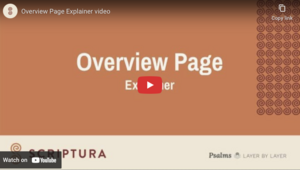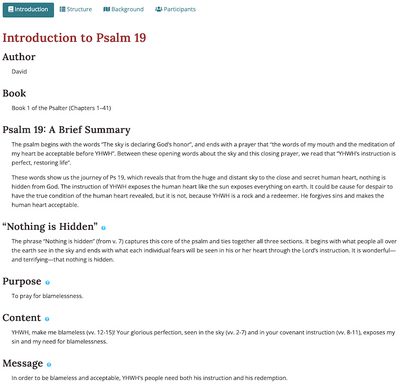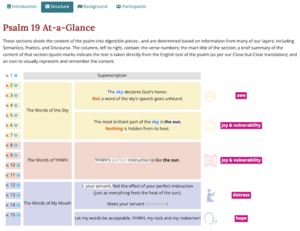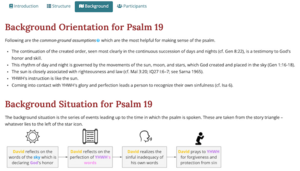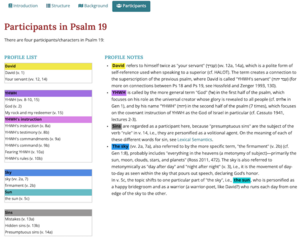User's Guide: Overview
User's Guide Contents
 Overview
Overview
While the Text Page is the best starting point to explore the psalm "bottom-up", beginning with the text, the Overview Page is the best place to start exploring the psalm "top-down", giving you a clear picture of the psalm and its message.
The Overview Page is designed to introduce and orient you to the psalm as a whole, before diving into the details. It includes the Overview Video and four sections: Introduction (highest level view), Structure (main sections and content), Background (the context of the Psalm), and Participants (who's who in the Psalm).
Overview Video
Our Overview Video introduces you to the psalm, its message, structure, emotions and background. The video walks you through the psalm section by section, providing a complete and coherent interpretation of the whole psalm.
Beneath the Overview Video we have four tabs, as illustrated below. Click on a tab to learn more about each section.
Introduction
This section provides the most essential information about the psalm:
Author
The author of the psalm.
- This is usually based on the superscription at the beginning of the psalm. In many cases the author is unspecified or determining the author is a difficult exegetical issue (for example in Ps 89).
- On David being the author of Psalms with his name, see here.
Book
Which book of the Psalter the psalm is in.
- Book 1: Chapters 1–41
- Book 2: Chapters 42-72
- Book 3: Chapters 73-89
- Book 4: Chapters 90-106
- Book 5: Chapters 107-150
The Psalm: A Brief Summary
The brief summary of the psalm is our attempt to summarize the content of the psalm as briefly as possible, giving you the big picture and most important information about the psalm.
Psalm Title
For each psalm we choose a title: a memorable phrase that helps remember the unique character and content of the psalm. In this paragraph we explain the reasoning behind our choice.
Purpose
The purpose of the psalm answers the question: “What was the psalmist trying to accomplish with this psalm?” The goal is to identify the author’s main aim expressed by the words of the psalm, and it will often be based on our Speech Act Analysis.
There are many possible purposes for a psalm.
- It could be to get God to act in a certain way. For example, the purpose of Psalm 3 is to ask God for protection and victory.
- It could be to get people to act in a certain way. For example, the purpose of Psalm 2 is to call the rebellious kings of the earth to submit to YHWH and his king. The purpose of Psalm 34 is to encourage others to fear YHWH.
- It could be to express an important truth, like confidence in YHWH in Psalm 23.
This information can be helpful for translators, performers, and artists when considering whether their rendition of the psalm accomplishes a similar purpose.
Content
The content of the psalm briefly summarizes the main points of the psalm. We aim to use succinct statements to capture the essence of the psalm and its different parts.
Message
The message of the psalm answers the question: “What did the psalmist want hearers/readers to understand and believe?" There can be multiple messages in a psalm, but we try to identify the most important message. Consider these examples:
- The message of Psalm 2 is that YHWH’s anointed king will rule the world.
- The message of Psalm 3 is that salvation and victory come from YHWH.
- The message of Psalm 23 is we lack nothing when YHWH is with us.
- The message of Psalm 34 is that YHWH protects and provides for those who fear him.
Structure
The Structure tab presents our At-a-Glance summary of the psalm’s structure and progression. This is the last and most important visual we create for every psalm. It is designed to help you visualize and internalize the psalm’s structure and content quickly and clearly. It includes the following:
- The main sections of the psalm with concise titles.
- The subsections of the psalm with brief text summaries.
- Visual icons for each section.
- The main emotions for each section.
- The expandable text of the psalm (hover over the Hover over these icons. symbol next to each verse).
Beneath the visual is a brief walk through of sections of the psalm and the progression of the psalm as whole.
Background
The Background tab, based primarily on our Story Behind resources, has two sections: Background Orientation and Background Situation.
- The Background Orientation provides the most important background information to understand the psalm in its original historical and literary context. This can be anything from a key concept or belief of ancient Israelites, a cultural practice in the Ancient Near East, other connected texts or themes in the Hebrew Bible, or important information about geography.
- The Background Situation lays out the key background events leading up to the events or situation of the psalm.
- For more information on Story Behind the Psalm, click here.
Participants
The Participants tab orients to who is who in the psalm and is taken directly from our Participant Analysis. Here we only include the complete list of participants in the psalm and profile notes giving important details about the participants. For more information on these resources, click here.
